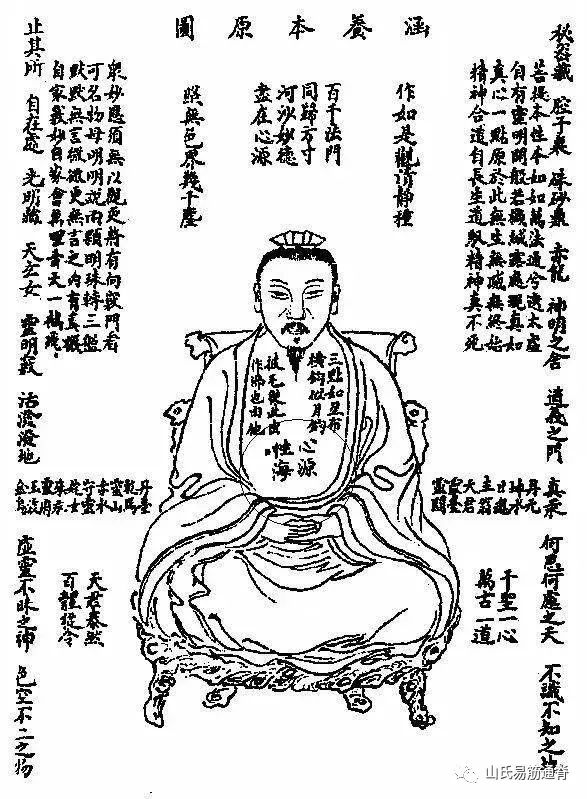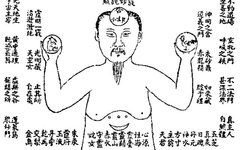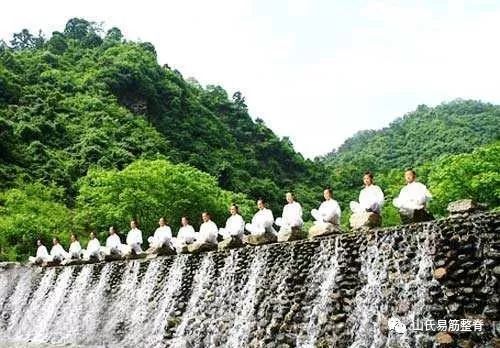
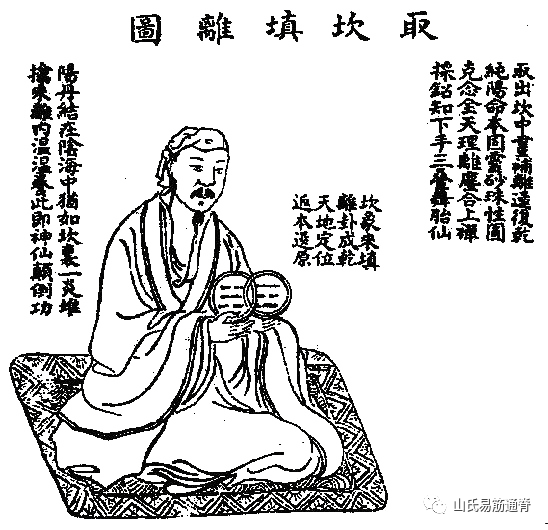 The locations of the Eight Points of the Great Circulation of Qigong and the Eight Meridians are as follows:
The locations of the Eight Points of the Great Circulation of Qigong and the Eight Meridians are as follows:
1. **Ren Point** (Ren Mai Ren Xue): The Ren channel represents responsibility; the heart is the master of the body, thus the Ren point is located at the heart. The heart governs intention, and everything arises from intention. The Ren channel begins at the **Cao Xi** (Cao Xi, Mouth), passes through the throat, **Shan Zhong** (Shan Zhong, Middle of the Chest), the navel, **Qi Hai** (Qi Hai, Sea of Qi), and connects with the **Du Mai** (Du Mai, Governing Vessel) at the perineum.
2. **Du Point** (Du Mai Du Xue): The Du channel represents guidance; the brain is the residence of the original spirit, thus the Du point is located in the brain. The Du channel begins at the perineum, travels through the tailbone, **Jia Ji** (Jia Ji, Spine), **Yuzhen** (Yuzhen, Jade Pillow), **Bai Hui** (Bai Hui, Hundred Meetings), **Yin Tang** (Yin Tang, Seal Hall), and reaches **Cao Xi**, connecting with the Ren channel. **Cao Xi**, known as the Magpie Bridge, is located in the mouth, as the lower jaw and gums resemble the riverbanks; the upper palate allows saliva to flow down, referred to as the stream, collectively called **Cao Xi**. In cultivating Daoist practices, this point is crucial, as the Ren and Du channels connect here via the tongue. Ancient practitioners placed great importance on saliva, likening it to nectar; they believed that the tongue is life, and a dry tongue signifies death. One must not casually spit out saliva; it should be collected and swallowed to nourish the organs and promote the generation of essence.
3. **Chong Point** (Chong Mai Chong Xue): The Chong channel represents the vital passage; the Chong point is located at the perineum. This point is a crucial juncture for the various Qi channels of the body. It is also the key to the two gates of the body. The path of refining essence into Qi and the secret to subduing dragons and tigers lie here. Practitioners should pay attention to this area. The Chong channel consists of a main channel and branch channels. The main channel starts at **Bai Hui** and descends to the perineum. The branch channels split into upper and lower branches. The upper branch starts at **Shan Zhong**, extends to both arms reaching the **Lao Gong** (Lao Gong, Palace of Labor) points in the hands, and ends at the tips of the five fingers. The lower branch starts at the perineum, extends to both legs reaching the **Yong Quan** (Yong Quan, Bubbling Spring) points in the feet, and ends at the tips of the five toes.
4. **Dai Point** (Dai Mai Dai Xue): The Dai channel represents the umbilical cord; this point is located at the navel. The Dai channel consists of three branches in the head, trunk, upper limbs, and lower limbs, plus a total body channel. The three head branches are located around the **Tian Ting** (Tian Ting, Celestial Court), the tip of the nose (the **Zhun Tou**), and **Cheng Jiang** (Cheng Jiang, Container of Fluids). The three trunk branches are located around **Shan Zhong**, the navel, and **Ling Yuan** (Ling Yuan, Spirit Source). The three upper limb branches are located around the shoulders, elbows, and wrists. The three lower limb branches are located around the hips, knees, and ankles. The total body channel splits from both sides of **Bai Hui**, travels through the ears and shoulders, along the outer sides of the arms to the back of the hands, reverses to the **Lao Gong** points, ascends along the inner sides of the arms to the armpits, passes through the ribs to the **Lai Kua**, and descends along the outer sides of the legs to the feet, reaching the tips of the five toes, reversing to the **Yong Quan** points, and ascending along the inner sides of the legs to the perineum as the endpoint. The Dai channel primarily runs through the skin and various joints.
5. **Wang Point** (Wang Mai Wang Xue): The Wang channel represents emotional entanglement. Everyone falls into the web of emotions; the reproductive organs are the handles of life, controlling the balance of creation, thus the Wang point is located here. The Wang channel: The Ren and Du channels are connected, circulating around the body, while the Chong channel reaches the four limbs, and the Dai channel surrounds the entire body, forming a cube. One should continue to circulate internal vital energy, reaching the organs internally and the skin externally, ensuring all channels are open, creating a network of Qi throughout the body, akin to a woven fishnet. Practicing the Wang channel may involve significant movement, with the body rotating left and right, utilizing internal vital energy to clear the meridians, which may cause dizziness, nausea, or a feeling akin to gas poisoning. If it becomes unbearable, one should pause and resume when feeling better (practitioners must not interrupt their practice at this critical juncture), continuing until there is no dizziness or nausea, at which point the internal organs are essentially open, and the body feels light as a swallow, rotating effortlessly without dizziness.
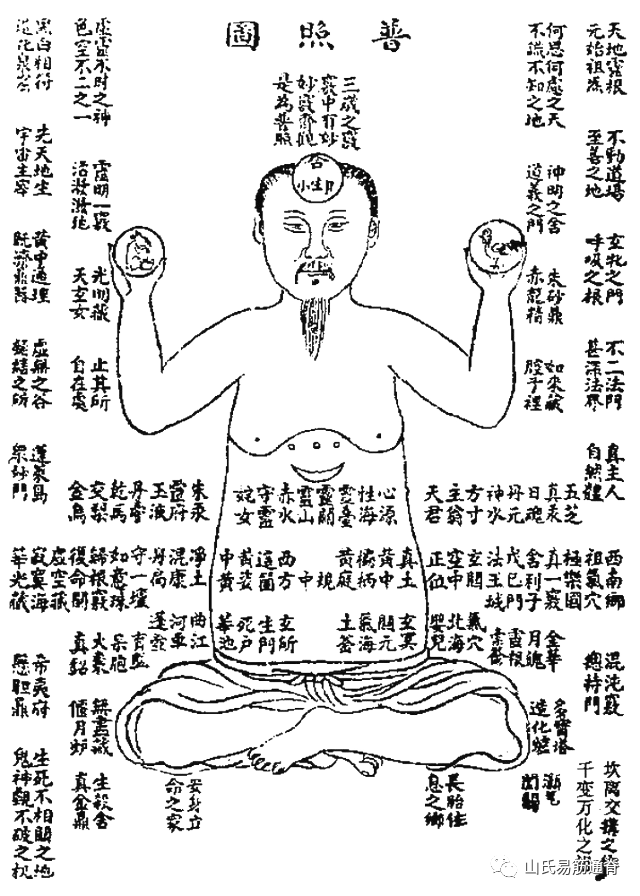
6. **Dan Point** (Dan Mai Dan Xue): The two eyes of a person are like the sun and moon; the Dan point is located in the eyes, with the left for males and the right for females. The Dan channel consists of internal and external channels. The internal channel: After completing the Wang channel, although the body’s pathways are interconnected like a net, there are still blockages that need to be cleared. One should continue to circulate internal vital energy to unblock these areas, achieving a unified state where the essence, Qi, and spirit are integrated, completing the Great Circulation of the human body. The external channel: After the internal channel is completed, one transitions from dynamic to static practice, with the breath becoming tranquil (possibly the fetal breath), closing the eyes and focusing, allowing the light from the Dan point to radiate outward, enveloping the body like a warm spring, thus promoting health and longevity. Additionally, one can utilize the external Dan energy to assist others in healing, but one must not harm one’s own vital energy.
In summary, the six methods of practice gradually develop from points, lines, surfaces, to the whole body. At this stage of practice, practitioners should pay attention to several points: 1. In cultivating the Dao, moral character is paramount; as the saying goes: “The Dao does not separate from virtue, and virtue does not separate from the Dao; otherwise, one will encounter demons; having virtue without the Dao leads to chaos.” One should perform good deeds and accumulate merit. 2. Learning is like rowing upstream; if one does not advance, one will retreat. One should persevere and not interrupt, or all previous efforts will be in vain. 3. Avoid complacency; one must understand that completing the Dan channel is only the beginning of the Daoist practice, akin to entering the first floor of a nine-story building; the journey ahead is long, requiring sincerity and effort to climb higher.
7. **Tian Point** (Tian Mai Tian Xue): The Tian point is located at the upper Dan Tian (two finger widths between the eyebrows), also known as the father orifice. This point opens all channels. The Tian channel: After refining the external Dan channel, the light from the eyes radiates outward, surrounding the body without straying far, akin to a toddler learning to walk. At this point, one should fill the Dan Tian with Qi, establishing a solid foundation, concentrating fully, calming the mind, and gazing at the Tian point, imagining a sun in the sky (for women, a moon), gradually opening the Tian point. At this moment, golden light shines brightly, resembling sunlight, radiating from the Tian point outward, initially moving slowly, and as one practices, one should gradually increase the distance, allowing the light to enter and exit freely, akin to a child progressing from crawling to walking, and eventually running, reaching the peak of non-action, achieving unity with heaven and humanity. The spiritual light exits the body, ethereal and elusive, soaring to the heavens and diving into the depths, freely roaming, expanding into the universe, and retracting into the depths, thus completing the Tian channel. This leads to the realm of refining the spirit and returning to the void. At this point, the physical body is merely the shell of the spiritual light; without this shell, the spiritual light cannot be cultivated, thus practitioners must cherish their physical form, engaging in both spiritual and physical cultivation, as without the false, the true cannot be realized, like jade within a stone. Only by reaching this state can one truly be called “the spirit of all things,” standing alongside heaven and earth.
8. **Li Point** (Li Mai Li Xue): The Li point is commonly referred to as the “Mysterious Gate.” It is also known as the ancestral orifice. This is the place of heavenly secrets, which cannot be spoken or written; this orifice relies entirely on the practitioner’s self-realization. The Li channel: After refining the Tian channel, one must continue to cultivate the spiritual light, achieving a state where one can enter fire without burning, enter water without drowning, and withstand fierce winds, completing the practice and understanding the Li point, from which the spiritual light radiates, avoiding fierce winds and reaching the vastness of space. At this point, all eight meridians of the Great Circulation of Qigong are fully completed.
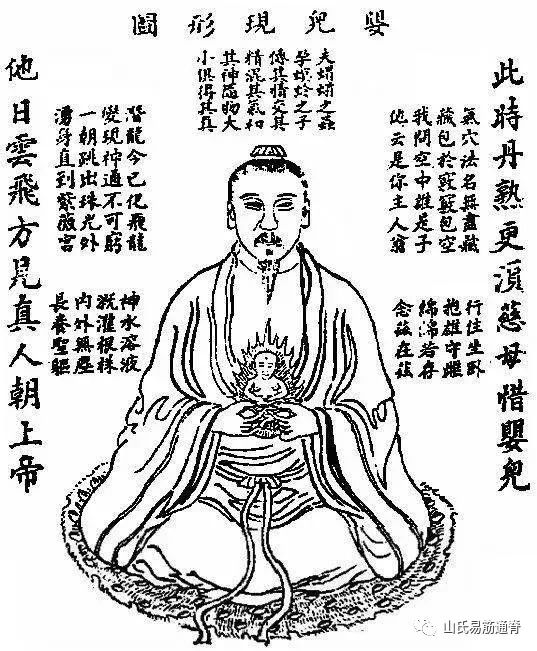
Steps of Practice
The practice of true Qi circulation involves five steps, primarily through adjusting the breath and focusing the mind, cultivating true Qi, opening the meridians, harmonizing Yin and Yang, and balancing Qi and blood… thereby allowing the inherent potential of the body to be tapped, leading to a series of self-healing effects, achieving disease prevention and treatment, developing wisdom, enhancing beauty, and prolonging life, making it a self-cultivating health care method.
The first step is to cultivate the fundamental postnatal essence, the second step is to open the Ren channel to allow true Qi to descend to the Dan Tian, the third step is to cultivate the true Qi in the Dan Tian, the fourth step is to connect the small circulation, and the fifth step is to continuously improve.
First step: Focus on the heart area during exhalation.
1. Method: Prepare for practice, relax the body and mind, concentrate, and keep the spirit inward while directing the intention towards the heart area during exhalation.
2. Time: To complete the first step on schedule, one must arrange time accordingly. If conditions permit, practice at a fixed time daily to develop a habit, which will help stabilize the mind. If there is no fixed time, it is still fine; just seize any opportunity to practice. It is recommended to practice three times a day, morning, noon, and evening, for twenty minutes each time. If done diligently, one can complete the first step in about a week.
3. Effect: In the initial days, due to unfamiliarity, the posture may not be accurate, and some practitioners may feel dizziness, soreness in the back, unnatural breathing, or the tongue not being able to touch the upper palate; these are all natural phenomena. There is no need for concern; as long as one persists in practice, these issues will gradually improve.
Second step: Intention and breath follow the Dan Tian.
1. Method: Each time you exhale, start from the heart area, focusing on the lower Dan Tian.
2. Time: Practice three times a day, each time for twenty-five minutes or half an hour; in about a week, the Qi should settle in the Dan Tian.
3. Effect: As the true Qi passes through the stomach area, the functions of the spleen and stomach improve. Once the true Qi settles in the Dan Tian, the surrounding organs, such as the large and small intestines, kidneys, and bladder, will gradually undergo physiological changes, generally leading to increased appetite and improved bowel habits.
Third step: Focus the mind and adjust the breath while guarding the Dan Tian.
1. Method: Focus on the Dan Tian during exhalation, but avoid excessive force in exhaling to prevent overheating the Dan Tian and depleting Yin fluids.
2. Time: Practice three times a day or even more, each time for over half an hour. This stage is crucial for cultivating the strength of the Dan Tian and requires a longer time; in about a month, one can feel fullness and strength in the lower abdomen.
3. Effect: With the Ren channel open and the heart and kidneys in harmony, the central Qi becomes vigorous, leading to a calm mind and restful sleep. Those suffering from heart fire, insomnia, and heart health issues will see improvements. Continuous practice increases warmth in the stomach, enhances the digestive capacity of the spleen and stomach, increases body weight, boosts energy, and strengthens kidney function. Those with erectile dysfunction will see significant improvements, and women with menstrual irregularities will also experience varying degrees of improvement. With abundant kidney water, the liver receives nourishment. Therefore, during this stage, those with chronic hepatitis and early-stage liver cirrhosis will see noticeable improvements. With consistent practice, natural healing will occur.
Fourth step: Open the Du channel, do not forget to return.
1. Method: Generally, follow the third step’s approach; as the true Qi ascends along the Du channel, the awareness should follow the upward force. This is “do not forget.” If it stops at a certain point, do not use intention to guide it. This is “do not assist.”
2. Time: The frequency of practice can be increased, and the duration should be extended to forty minutes or an hour. Each person’s situation is different, so the time and strength required to open the Du channel will vary. Some may pass through instantly with great force, while others may take longer with less force. Most will open the Du channel in about ten days.
3. Effect: After opening the Du channel, with each exhalation, true Qi enters the Dan Tian, and with each inhalation, true Qi enters the brain; however, do not pursue this intentionally. This forms a cycle of the Ren and Du channels, known in health circles as the “small circulation.” Only in this state can one feel the actual situation of “breathing in essence and guarding the spirit.” True Qi continuously nourishes the brain marrow, enhancing the innate energy of the cerebral cortex. Symptoms caused by kidney essence deficiency and endocrine disorders, such as dizziness, tinnitus, insomnia, forgetfulness, lower back pain, leg weakness, menstrual irregularities, mental confusion, irritability, palpitations, shortness of breath, and decreased libido, can all improve. With long-term persistence, recovery is possible. Due to the smooth meridians from practice, some long-standing stubborn ailments may also resolve quickly, showing significant effects. Generally, this results in abundant energy and a light body.
Fifth step: Cultivate the original spirit to nurture vitality.
The so-called original spirit is the innate energy regulated by the brain, in contrast to the conscious spirit. The conscious spirit is the state of awareness. The original spirit and conscious spirit represent the relationship between essence and function, with the original spirit as essence and the conscious spirit as function. After the fourth step, the Du channel is open, and kidney Qi continuously nourishes the brain marrow, thus the power of the original spirit is constantly replenished. The heart governs the spirit, and the heart Qi illuminates the brain, enabling comprehensive regulatory control.
1. Method: Generally, continue to guard the lower Dan Tian. The Dan Tian is the area of long-term focus. After opening the Du channel, all meridians will successively open. If there is activity at the Bai Hui (upper Dan Tian), one can also focus on the top of the head. This can be flexibly adjusted, known as “observing the orifice with desire, observing the wonder without desire.”
2. Time: Practice three times a day or more, each time for an hour or longer. In general, the longer the time, the better. After about a month, various sensations in the body will gradually diminish, leaving only the strength of the lower and upper Dan Tian more concentrated and vigorous.
3. Effect: Based on the body’s performance, especially the magnetic attraction between the Dan Tian and Bai Hui, it indicates that the innate energy of the cerebral cortex is enhanced, and the endocrine system is coordinated and vigorous. This energy is tangible and colorful; the deeper the practice, the more lively and pronounced it becomes, leading to better regulation of the physiological functions of the body. True Qi becomes more abundant, continuously compensating and enhancing the body’s metabolic functions, fully unleashing the body’s potential. With increased vitality, immunity against diseases is enhanced, generally reducing or even avoiding pathogenic factors, and existing chronic ailments can improve or heal. With consistent practice, one can achieve physical and mental health and longevity.
The above five steps summarize the basic overview of the true Qi circulation method in static practice. In practice, due to individual differences in constitution and specific conditions, the effects and manifestations will also vary. Therefore, during practice, one should follow nature, apply flexibility, and not be overly rigid; yet, one should adhere to certain requirements, patiently seek progress, and persistently practice, as this is the key to success.
Step-by-step Guidance
The true Qi circulation method is praised for its simplicity and effectiveness, making it popular among practitioners and patients. To learn and practice the true method, one should carefully read and study the practical content in the book, thoroughly contemplate and experience it, and temporarily avoid delving too deeply into the theoretical discussions to prevent excessive thinking and distractions during practice. Initially, one should simply follow the “method” faithfully. To provide correct guidance for more practitioners of the true method, with the consent of Professor Li Shaobo, the key requirements for the “Five Steps Completion” are now published as follows.
**First Section: Guidance for the First Step of the True Method**
1. Focus on the heart area during exhalation: The heart area is located at the center of the chest, just below the sternum (the protective bone of the heart), which is essentially where the stomach is located. This is a region, not a specific point.
2. Attention: This means to think about it, to guard the area with intention. The guarded area refers to the internal region of the body.
3. Exhalation: The true method uses natural breathing through the nose. Natural breathing means not artificially controlling the rhythm of breathing, but allowing it to flow naturally. The key is to focus on the heart area during exhalation, while inhalation should be natural, without forcing attention on it.
4. When starting to practice Qigong and the true method, practitioners often have many distractions and find it difficult to calm down, making it challenging to maintain focus on the heart area during each exhalation. One can use a counting method to assist, counting from one to ten with each exhalation, then starting over. This can help guide one into a meditative state.
5. Emphasizing attention on exhalation may lead some to feel unnatural breathing or even a sense of suffocation. This is because they are not only focusing on exhalation but also consciously extending it, which can lead to a feeling of suffocation. It is important to avoid this. Once one truly understands how to breathe naturally, there will be no feeling of suffocation.
6. The sign of completing the first step is a warm or full sensation in the heart area, or a feeling of pressure; one can then transition to practicing the second step. For those with stomach issues or a cold constitution, it may take longer to feel warmth; however, as long as there is a feeling of fullness or pressure, it is a sign of Qi, and one can proceed to the second step.
**Second Section: Guidance for the Second Step of the True Method**
The second step is to follow the intention and breath towards the Dan Tian, with the following points to grasp.
1. The meaning of intention and breath following: Intention refers to thought, and breath refers to exhalation (also indicating the warmth of true Qi), which are interdependent.
2. The direction towards the Dan Tian: This means that during exhalation, the intention should guide the warmth from the heart area step by step down to the Dan Tian. The natural flow of true Qi is that during exhalation, it moves downward and outward, while during inhalation, it moves upward and inward. The purpose of this step is to guide the true Qi gathered in the heart area down the Ren channel to the Dan Tian, thus opening the Ren channel.
3. The most common reaction during this step is intestinal sounds and gas, which indicate that true Qi has strengthened the function of the intestines, and the righteous Qi is expelling the turbid Qi from the intestines; this is a normal phenomenon and should be allowed to occur naturally without control. At this stage, some patients with intestinal inflammation may experience bloody stools; there is no need for panic, and medication is not necessarily required, as the expulsion of turbid matter will lead to natural healing.
4. For patients with abdominal surgeries, scarring may obstruct the flow of Qi, making it difficult for true Qi to descend, and they may experience pain at the surgical site; this is a reaction to the true Qi clearing the meridians. The Qi may take longer to reach the Dan Tian. Practitioners should strengthen their practice and spend more time on it. Some may feel Qi rising, which indicates blockage in the lower burner, or it may be due to focusing on inhalation; attention should be directed to exhalation to guide the Qi downward; once the Qi in the three burners is smooth, true Qi will easily settle in the Dan Tian.
**Third Section: Guidance for the Third Step of the True Method**
After practicing the first two steps, one should have a preliminary experience. When the second step is practiced to the point where each exhalation directs Qi to the Dan Tian, one can enter the third step, practicing the third step of “focusing the mind and adjusting the breath while guarding the Dan Tian.” This third step is the most important in completing the five-step method. The first two steps are to cultivate true Qi and open the Ren channel, guiding the Qi towards the Dan Tian and gathering it there. The third step lays the foundation for the next step of opening the Du channel; if the true Qi in the Dan Tian is insufficient, opening the Du channel will not be possible. Therefore, ancient practitioners referred to this step as “building the foundation.” Due to the importance of cultivating the strength of the Dan Tian, this step requires a longer practice time. After entering the third step, the following situations may often arise.
1. When the true Qi enters the Dan Tian during the second step, there may not be a noticeable feeling in the Dan Tian initially, and later on, the sensation may diminish. Some may feel anxious about this, not understanding why, or think that the practice has gone awry. There are two reasons for this: first, the focus of the third step is on concentrating the mind (i.e., guarding the Dan Tian), which may lead to a relaxation of the intention to focus on exhalation, thus reducing the force of Qi settling in the Dan Tian; second, the Dan Tian has a large capacity, and when Qi enters, it may feel dynamic, but a small amount of Qi is insufficient to fill the Dan Tian, leading to a lack of sensation. Continuing practice for a few days will allow the Dan Tian to fill up, and sensations will naturally return; this is a necessary phenomenon in the process of progress.
2. As the practice progresses, the true Qi in the Dan Tian becomes increasingly abundant, leading to various sensations. The most appropriate sensation is a “warmth in the Dan Tian.” If there is excessive heat, it indicates that the practice is too intense; one should relax the exhalation or not focus on it to reduce the heat. A “full Dan Tian” indicates that true Qi is abundant, and it must reach a certain level before it can move downward (to the perineum) or backward (to the Ming Men); this should occur naturally and not be forced. The sensation of the Dan Tian opening and closing, feeling as if something is moving within, or sensing a rhythmic expansion and contraction, is often referred to as “fetal breath,” indicating that true Qi is vigorous in the Dan Tian, which is a very good sign, allowing for better focus on the Dan Tian. The sensation of a “Dan pearl” in the Dan Tian, resembling a solid object the size of a chicken egg or a child’s fist, is referred to as “Dan” by ancient practitioners, indicating a high concentration of true Qi. These are common internal experiences encountered before and after opening the channels and are very encouraging signs that should be carefully maintained. However, these phenomena vary from person to person, and not everyone will experience all of them; if they do not occur, there is no need to force them.
3. With the third step, as the true Qi in the Dan Tian becomes abundant, there will be many physiological changes throughout the body, such as a flow of Qi circulating around the waist, passing through the navel and the Ming Men, continuously rotating; this indicates that the Dai channel is open, which is very helpful for opening the channels. A warm sensation throughout the body is also common, indicating increased energy, which enhances resistance; however, if someone experiences excessive heat and feels uncomfortable, they can use the “He” sound from the six-character formula to calm down. Those with gastric ptosis may often feel the lower abdomen lifting during exhalation in the third step, indicating that the stomach’s function is recovering and gaining strength, which is a fundamental factor in healing gastric ptosis, and there is no need for concern. If Qi flows towards the thighs, this is generally normal and should not be overly worried about; if the downward flow of Qi is too strong, making it difficult for the Dan Tian to accumulate Qi, one can switch to a seated position to correct this. If there is a desire to turn backward and it cannot be achieved, one can lift the anus while inhaling to guide it; if excessive true Qi leads to excitement of the nervous system and causes nocturnal emissions, this is most likely to occur at this stage, and one should pay close attention, promptly using the “Inhale (inhale), Resist (tongue against the palate), Gather (lift the anus), Close (close the eyes)” method to prevent and treat it.
4. To successfully open the Du channel in the fourth step, one must rely on the accumulation of true Qi from the third step, known as “accumulating Qi to open the channels.” If true Qi leaks out, the opening will be delayed, so practitioners are advised to maintain a clear mind and avoid desires before sleep, sleeping in a curled position on their side, known as “sleeping like a bow”; the pants should be loose to avoid friction; the bedding should be light and not too warm, and avoid sleeping on the back. If there are sexual urges, one should get up and practice instead of sleeping. If one can maintain this for several days, it is a crucial stage that must be adhered to. Those who frequently experience nocturnal emissions should pay attention to the above requirements and consider practicing at the times they usually experience emissions to correct their habits. Many have healed using this method. Those with intestinal inflammation who experience bloody stools during the third step, or women with gynecological issues who expel matter, this is the effect of true Qi acting on the surrounding organs of the Dan Tian, leading to beneficial physiological changes, thus not requiring other treatments for healing. One should ensure that the Dan Tian is full, and the phenomena of meridian activation throughout the body gradually increase, with various points experiencing pulsations, itching, numbness, or rashes; this indicates that true Qi is expelling evil Qi, and no treatment is needed, as the evil will naturally heal. After the third step, various sensations will increase, and further guidance will be provided in the fourth step.
**Fourth Section: Guidance for the Fourth Step of the True Method**
The fourth step begins when the true Qi in the Dan Tian has reached a certain level, passing through the perineum, around the tailbone, but some may feel the sensation of Qi moving towards the Ming Men without passing through the perineum first; this varies from person to person and should not be forced. In the fourth step, many physiological changes occur. The following are common issues that may arise:
1. If exhalation is too forceful, it may cause excessive heat in the Dan Tian; if one feels a burning sensation, reduce the intensity of exhalation or stop focusing on exhalation to correct it naturally. Generally, a warm sensation is good; if someone exhales too forcefully or experiences strong reactions in the perineum due to sexual activity, leading to fear of leakage, the more one is tense and focused, the stronger the reaction will be, causing anxiety, leading to a drop in central Qi, dizziness, and weakness in the limbs. The remedy is to pay less attention to exhalation or not focus on it, and during natural inhalation, gently lift the anus, gradually correcting the situation until true Qi passes through the tailbone and ascends along the Du channel.
2. Some may rush to open the channels without waiting for the true Qi in the Dan Tian to be sufficient, leading to insufficient true Qi for guiding upward, causing stagnation and discomfort. The correction is to firmly guard the Dan Tian and continue cultivating true Qi; once the Qi is sufficient, it will open the channels naturally without further guidance. “Do not forget to assist” means just this.
3. The fourth step is the most challenging and crucial step in the entire practice, often referred to by ancient practitioners as “rebirth.” Due to the particularly noticeable physiological changes and some discomfort, practitioners may feel lost and anxious, seeking help, which is unnecessary (as explained in the book). When true Qi passes through the Ming Men, those with a history of lower back pain will inevitably feel discomfort. These are manifestations of the struggle between righteousness and evil, correcting the condition; once true Qi passes through, healing will occur, and there is no need to seek correction or diagnosis. At this time, one should intensify practice, increasing the frequency and duration compared to usual, and once the channels are opened, all discomfort will alleviate; do not slacken and cause self-harm.
4. Professor Li Shaobo summarized the process and practice of opening the Du channel with eight sentences, known as the “Zhou Tian Song” (Great Circulation Song). (Refer to the essence section for details); practitioners must carefully contemplate this to understand.
**Fifth Section: Guidance for the Fifth Step of the True Method**
After opening the Du channel, one enters the fifth step, which in the context of the Great Circulation, is considered to have achieved the goal. Many people ask how to practice after opening the channels. The true Qi circulation method has further content and stages for improvement, and here are several aspects to pay attention to as requirements for continued practice:
1. The true Qi circulation method involves a step-by-step approach to connecting the Ren and Du channels; as long as one follows the conditions formed during practice and regularly increases the effort, success will come. The book emphasizes persistence and following nature; the deeper the practice, the better the results. Opening the channels is merely the completion of the foundational stage; continued practice is necessary to achieve good results. Especially for those practicing for health, improvements in constitution and physical quality can be seen even before opening the channels, and some mild functional diseases can be cured. However, serious and stubborn organic diseases will require time to continuously strengthen true Qi and expel illness. One should not assume that once the channels are opened, all ailments will be cured; however, with persistence, various diseases will gradually improve.
2. After opening the channels, there may still be many reactions of Qi attacking disease sites, leaving practitioners unsure of how to respond. For example, during the initial opening, if Qi is swirling in the head, causing a feeling of heaviness in the forehead, one can simply ignore it. Just focus on the upper Dan Tian, concentrating energy at **Bai Hui** (the meeting point of the hundred channels), which will help reduce other chaotic sensations, but this may take time. Prolonged focus on this point can also develop wisdom and enhance intelligence. If after opening the channels one feels a lack of true Qi or that digestive function has worsened, one can focus on the middle Dan Tian to replenish central Qi, which will also enhance the true Qi in the lower Dan Tian. The lower Dan Tian is the area of long-term focus, and it is always appropriate to guard this area.
3. Emphasizing stillness is crucial; the deeper the practice, the better the stillness. Only by achieving deep stillness can the physiological functions of the body recover better; this is the natural law of stillness leading to movement, previously referred to as the “Dao.” Ancient practitioners called this level of practice “cultivating the Dao.” The concept of stillness permeates the entirety of cultivating the Dao; initially, one cannot achieve stillness, so methods must be employed to gradually enter the door and slowly reach a state of stillness. Therefore, after the five steps, there is no need to pursue this method or that method; in fact, pursuing methods can lead to distractions. Once deep stillness is achieved, one can experience the unity of the three Dan Tians, entering a state of emptiness where there is no self and no object; what methods are there to pursue? Of course, the advanced realms of the true method are also tiered and staged, achieved step by step, which belong to the advanced class of the true method and can be pursued for further development and improvement in the future.
